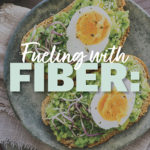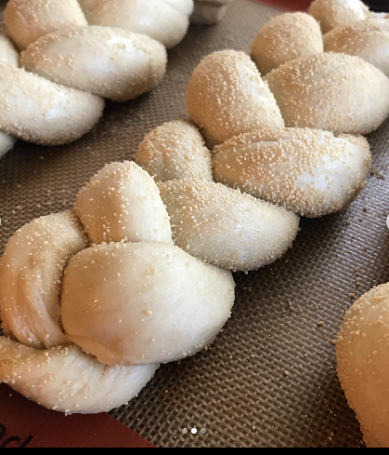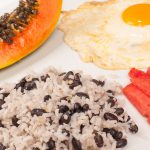Determined by the Hebrew calendar, Rosh Hashana, Yom Kippur, and Sukkot fall on different dates each year, typically between September and October. Let’s take a closer look at each of these religious holidays and some of their culinary traditions.
Rosh Hashana
Rosh Hashana, meaning “head of the year,” celebrates the Jewish new year and commemorates the birth of the universe. A time to celebrate new beginnings, Rosh Hashana is a period of prayer, blessings, and reflection. This year it occurred from September 25 to 27.
Like many Jewish holidays, food plays an important and symbolic role in the celebration. Families feast throughout the holiday period, which lasts two days. Celebrants eat challah — a type of braided, ceremonial bread — and dip morsels into honey as a wish for a sweet year. The challah served during Rosh Hashana is baked in round loaves to represent the endless cycle of life and creation.
Other sweet items consumed during the holiday can include apples dipped in honey, pomegranates, tzimmes — a sweet carrot dish — and a fruit that’s newly in season. In the past, it was tradition to eat parts of a fish or ram’s head, symbolizing the beginning (or the head) of the new year. Today, gummy bears are used as a symbol and enjoyed by people of all ages!
Yom Kippur
Taking place about a week after Rosh Hashana, Yom Kippur — the Day of Atonement — is the holiest and most somber holiday in the Jewish faith. This year it begins at sunset on October 4 and ends the evening of October 5. Yom Kippur is a day of fasting and prayer, but the day before the holiday is a time of feasting and preparation.
Pre-fast meals can include traditional fare like rice, stuffed dumplings, challah, chicken, or fish. The food eaten to break the Yom Kippur fast is a bit heavier or more indulgent and includes bread and dairy. For example, sweet kugel is served along with bagels, quiche, eggs, cheese, and sometimes soup or brisket.
Sukkot
Five days after Yom Kippur is Sukkot (October 9 to 16 this year), a weeklong holiday or harvest festival celebrating the Israelites’ divine protection when they fled Egypt. Celebrants construct a temporary shelter called a sukkah to honor the passage through the Sinai desert and the dwelling provided throughout the journey. The sukkah is comprised of at least three walls and includes natural vegetation, usually on the roof. At a minimum, participants consume all meals in the sukkah during the week, but the goal is to spend as much time as possible in the shelter throughout the observance.
As Sukkot celebrates the harvest or bounty, it’s common to see holiday meals include fresh fruits, vegetables, and other ingredients related to harvest. Kreplach, or dumplings, are the only traditional dish served during Sukkot (on the seventh day), so recipes will vary by family tradition and country of origin. A meal during this holiday could include anything from salads and gefilte fish to cabbage rolls and matzo ball soup.
Perfect for a fall holiday meal, try this recipe today!
House-Made Challah
Servings: 16
Ingredients:
4 ½ cups bread flour
1 ⅓ cups warm water
1 tablespoon active dry yeast
2 eggs
5 ⅓ tablespoons vegetable oil
1 ½ teaspoons salt
¼ cup granulated sugar
1 egg (for egg wash)
1 tablespoon water (for egg wash)
STEP 1: Preheat oven to 375°F.
STEP 2: Combine bread flour, warm water, yeast, eggs, oil, salt, and sugar. Blend with a dough hook until mixture is elastic and pulls away from the sides of the mixing bowl. Cover bowl with a towel and place in a draft-free spot. Allow the dough to proof until it doubles in size.
STEP 3: Punch down and divide into 1-pound portions. Divide each portion into 3 and roll each into long cylinders. The cylinders should be about 1 ½ to 2 inches in thickness.
STEP 4: Braid the 3 cylinders together by fixing together at one end and fanning other ends out. Lift the middle cylinder up and move the right cylinder to the middle. Lift the middle cylinder up and move the left cylinder to the middle. Continue alternating each side, lifting the middle cylinder each time before making the next braid, until portion is fully braided. Fix the ends together at the end of the braid. Repeat with remaining dough.
STEP 5: Transfer to sheet pans, cover, and allow to rise for 20 minutes.
STEP 6: Combine the remaining egg and water; mix well. Brush onto loaves. Bake for 20 to 35 minutes or until golden brown.









